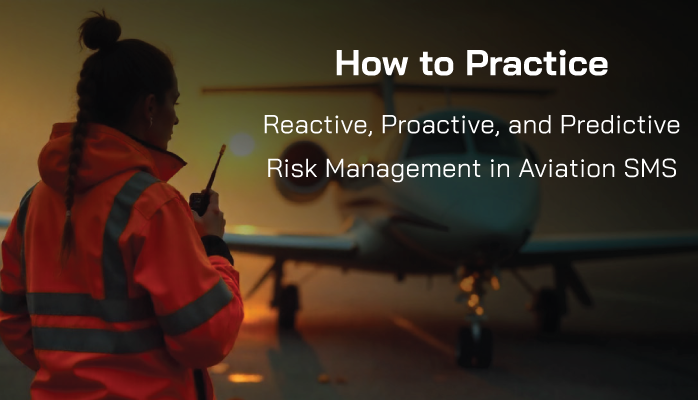What It Means to Practice Reactive, Proactive, and Predictive Risk Management

If you want to practice reactive, proactive, and predictive risk management in aviation safety management systems (SMS), you first and foremost need to understand the difference between these types of risk management in modern aviation operations.
Understanding what each type of risk management is does not involve just understanding the “conceptual” difference, but how each practice differs in the actual operational environment.
Related Aviation Risk Management Articles
- Difference Between Reactive, Predictive and Proactive Risk Management in Aviation SMS
- From Reactive to Proactive Risk Management in Aviation SMS
- 5 Indicators of Reactive or Proactive Safety Culture in Your Aviation SMS
The most common misnomers around the types of aviation risk management are:
- Predictive/proactive are “better” forms of risk management than reactive;
- There is little difference between predictive/proactive; and
- Inability to clearly define what each type of risk management looks like.
Here is a table that very broadly defines the difference between each type of risk management:
|
|
Reactive Risk Mgmt |
Proactive Risk Mgmt |
Predictive Risk Mgmt |
|
Definition |
Actions in response to hazard/risk occurrence |
Actions that address perceived hazard/risk occurrence before it actually occurs |
Actions that attempt to forecast future, potential hazard/risk occurrence |
|
Primary Management Activity
|
After hazard/risk occurrence, taking measures (i.e., corrective actions) to prevent re-occurrence |
Before hazard/risk occurrence, creating control measures to prevent initial occurrence |
Analyzing current operations to identify areas of potential concern in the future, hypothetical situation |
|
Primary Front-Line Employee Activity
|
Once hazard occurs, take action to prevent risk occurrence, or if the risk occurs, actions to mitigate damages |
Hazard mechanisms and threats are identified before hazard occurrence (and hazard occurrence is mitigated) |
N/A
|
The important distinction above in practicing reactive, proactive, and prediction risk management happens on a bureaucratic/management level, as well as an issue-by-issue operational environment level.
Related Aviation SMS Risk Management Articles
- Best Low Cost Risk Management Tools to Use in Aviation SMS
- How Aviation Safety Managers Reach Predictive Analysis Phase
- Going From Reactive to Predictive Risk Management in Aviation SMS
How to Practice Reactive Risk Management

Reactive risk management is the first type of risk management that an aviation SMS will practice. We might call this “baseline” risk management because it’s the type of risk management process that will be built first in safety programs. Here are the basic elements of practicing reactive risk management.
Resources you need to practice reactive risk management:
- A hazard reporting and risk management system, such as through Excel or aviation safety management software;
- Understanding how to classify safety issues;
- Ability to create and assign corrective preventative actions (CPAs);
- Reactive risk management training; and
- Understanding of link between hazard and risk occurrence in your safety program.
Top activities of reactive risk management:
- Creating corrective actions;
- Classifying safety issues as they are reported;
- Root cause analysis (can be proactive too) on safety issues;
- Investigation of safety issues; and
- Risk mitigation training.
Outcomes and goals of reactive risk management:
- Prevent risk occurrence after hazard occurrence;
- Mitigate potential damages and consequences of risk occurrence;
- Monitor effectiveness of risk controls; and
- Prevent the recurrence of a safety issue.
Related Reactive Risk Management in Aviation Articles
- How to Monitor the Effectiveness of Control Measures
- How to Be Compliant With Safety Performance Monitoring and Measurement
- How to Automate Key Performance Indicator KPI Monitoring the Easy Way
How to Practice Proactive Risk Management
Proactive risk management is a risk management practice that will begin to grow after aviation safety programs have:
- Enough historical data to begin to establish trends and precursors; and/or
- Developed supporting safety cultures that increase proactive hazard identification and reporting among employees.
In short, proactive risk management will be more relevant as an SMS implementation matures and employees embrace the concepts of just culture.
Here are the basic elements of practicing proactive risk management.
Resources you need to practice proactive risk management:
- Historical data;
- Sophisticated data analysis tools;
- Well-established key performance indicators or leading indicators;
- Effective methods to promote safety agenda;
- Ability to quickly and efficiently create and monitor risk controls; and
- Understanding main root causes, hazard mechanisms, and threats to SMS program.
Top activities of proactive risk management:
- Creating risk controls around expected hazard occurrence;
- Creating checklists and procedures;
- Listing (identifying) and establishing top root causes;
- Analysis of classification data in order to understand areas of exposure;
- Emergency response drills;
- Consistent safety promotion efforts, i.e., newsletters, surveys, banners; and
- Identify growing threats from root causes before the hazard occurs.
Outcomes and goals of proactive risk management:
- Prevent hazard occurrence that can reasonably be prevented;
- Actively seek out exposure before it becomes a safety concern;
- Increase identification technique and ability of hazard mechanisms; and
- Understand underlying causes of safety behavior.
Related Proactive Risk Management in SMS Articles
- How to Practice Proactive Risk Management in Aviation Safety
- Proactive Risk Management: What Root Causes Say About Management
- 5 Signs of Good Aviation Risk Management Training
How to Practice Predictive Risk Management

Predicative risk management involves attempting to foresee safety concerns that have not occurred in the operational environment by reviewing and analyzing historical data. Trend analysis is perhaps the most well-known predictive risk management tool in a safety manager's toolkit.
Predictive risk management involves looking at operational processes and attempting to understand how those processes might fail in a given situation. You might call predictive risk management “hypothetical stress testing for SMS.”
Resources you need to effectively practice predictive risk management:
- Very strong operational processes;
- Strong understanding of operational systems and ability to imagine them in a given situation;
- Historical data in order to know how people and SMS respond to certain situations;
- Tools to easily classify safety concerns and audit findings;
- Efficient and timely ability to retrieve data and analyze trends;
- List of key performance indicators to focus data analysis activities; and
- Strong understanding of Human Factors in the operational environment.
Top activities of predictive risk management:
- Safety cases;
- Data analysis;
- Trend identification;
- Management of change; and
- Hypothetical scenario analysis.
Outcomes and goals of predictive risk management:
- Identify new hazards;
- Verify effectiveness of risk controls;
- Assess performance limits of the safety management system;
- Review operational processes for areas of potential exposure; and
- Demonstrate continuous improvement of the aviation SMS.
Related Predictive Risk Management in Aviation SMS Articles
- Aviation Safety Managers' Best Friend - Trending Charts
- How to Prepare Data for Trend Analysis in Risk Management Programs
- Six Steps How to Perform Trend Analysis in Aviation SMS
Final Thought: Practicing All Types of Risk Management
The important takeaway when understanding all three types of risk management are:
- Know when to use which type of risk management;
- Understand in which types of risk management your organization is strong/weak;
- Be clear about which type of risk management you are currently practicing; and
- Establish clear, relevant activities for your aviation SMS program.
To increase your ability to sustainably practice risk management in your aviation SMS, you will find that an SMS database is the required technology to acquire, store, and retrieve safety data.
One of your ultimate objectives as a safety manager is to successfully engage in predictive risk management activities year after year. The SMS database is critical to saving time and energy for the safety team. You will also increase your level of safety, reduce risk, and reap the real benefits of having an SMS database software program that can be used for all aviation SMS activities, including:
- Hazard reporting;
- Managing the SMS implementation process;
- Risk management;
- Safety assurance; and
- Safety promotion.
If you want to have a real SMS and not a paper SMS, we can help you achieve your goals. Ask us to be your SMS partner.
Last updated November 2025.







